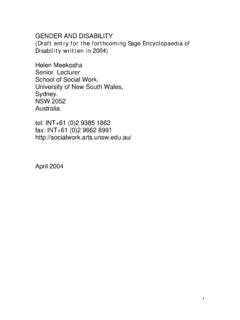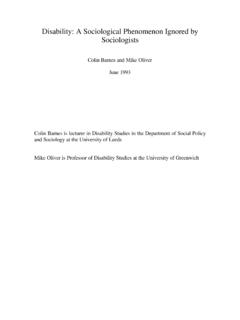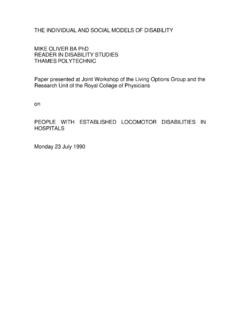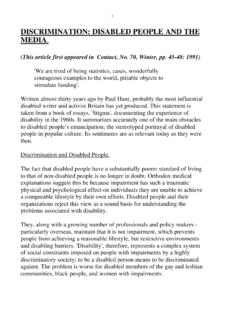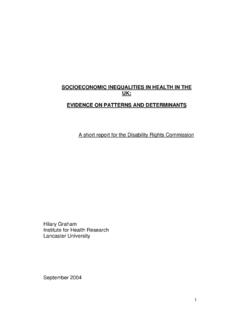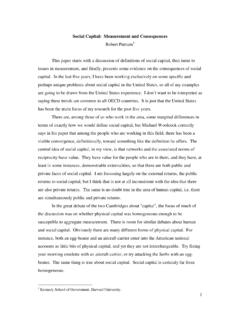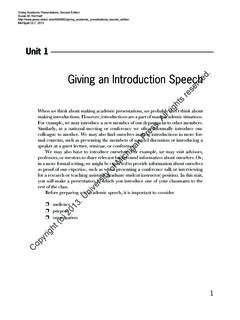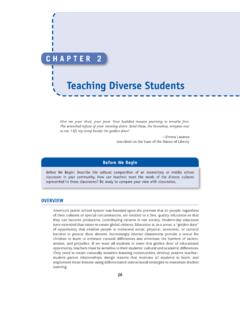Transcription of defining impairment and disability
1 defining impairment and disability A disabled person is a person with an impairment who experiences disability . disability is the result of negative interactions that take place between a person with an impairment and her or his social environment. impairment is thus part of a negative interaction, but it is not the cause of, nor does it justify, disability . impairment : an injury, illness, or congenital condition that causes or is likely to cause a loss or difference of physiological or psychological function. disability : the loss or limitation of opportunities to take part in society on an equal level with others due to social and environmental barriers.
2 Appendix A is an explanation of the thinking behind the definition. Appendix B contains a phrase-by-phrase analysis of how the text of the NOG social definition can be defined precisely in organisational terms. Page 1 Appendix A defining impairment and disability Background Members of the Northern Officer Group (NOG) have formulated the following definition. NOG is an organisation of disabled people who work in local government. The definition has been prepared in response to the particular barriers experienced by our members during their attempts to bring about organisational change within local government.
3 The importance of definitions From our experience of working in local government, we have learnt that definitions of disability can influence the way in which non-disabled people respond to disabled people. That is, a definition can place limits not merely on what is possible, but what is thinkable in an organisation. This is particularly so when the definition is built into organisational policy, procedure, and practice, and used in training sessions and guidance notes. The role of definitions in organisational change Organisations (whether they be community groups or large local authorities) are, at their simplest level, a series of relatively coordinated and predictable events: for example, people come and go at more or less predictable times and are expected to carry out predetermined tasks in a relatively predictable manner.
4 Within organisations, people have to give reasons for changing the rules that guide and shape such events. The validity of the reasons is often measured by making judgments about those people who need flexibility and organisational resources, and those who simply want them. For example, distinctions are made between those people who need to start work after nine thirty because of taking children to nursery and those who want to start work later because it is simply convenient for them. Similarly, when someone takes sick leave they are expected to show that they need to stay at home and not just that they want to.
5 The weight given to any particular definition of want or need depends on many things including the authority of the person putting the case. For example, a manager s arguments may carry more weight simply because of their position in the organisation. Also, the language for talking about needs and wants will formulate the sort of questions to be asked and the knowledge used for devising solutions to the problem. Thus, the language used does not simply reflect reality it creates it within particular relations of power. As things are now, people with impairments who require changes in organisational rules are encouraged to show that it is their individual impairment that gives rise to a need for organisational change.
6 For example, I can t sort the mail because I am Page 2 partially sighted! The organisation is thus asked to respond to an individual s (tragic) loss. This individual approach to disability gives rise to two potential problems. Firstly, because people with impairments are forced to articulate their needs in terms of deficiencies in their own bodies they consistently have to show that they are sub-standard; that their impairment equates to a deficiency in their whole identity. Secondly, when organisational change is founded on the needs of an individual, change is seen as a one-off arrangement.
7 For example, we have made arrangements for Smithers in accounts because she s partially sighted . The problem is that such organisational arrangements often depend on the good will of particular colleagues, who, for example, choose to make time to arrange audiotaping. However, this sort of arrangement is fragile - it is likely to break down if the helpful colleague is on holiday or changes job. Furthermore, if say, the accounting procedures that facilitate the helpful colleague s actions change, such change may easily fail to acknowledge the existence of an informal adjustment.
8 Also, arrangements made to suit one individual do nothing to increase disabled people s access to the organisation in general, either as employees or as customers. If, however, the problem of disability was turned on its head and impairment was not seen to be the cause of the need , a different and more positive picture of disabled people may emerge. In addition, if the arguments for organisational change were put differently - if people were to use different ideas and ways of thinking to engineer change - the chances of change become part of the organisational culture would increase.
9 Thus, we can either say that people with impairments cannot carry out a particular task because of their impairment or we can say that because those organisational procedures that facilitate such a task have developed in the absence of people with impairments they cannot accommodate their requirements. This approach to disability has the advantage of encouraging people in organisations to identify those forms of social organisation that disable people with impairments. Thus, when such an approach is taken the collective informed experience of people facing disabling barriers can be become the arbiter of social justice and not the subjective experiences of individuals.
10 There will of course come a point where the organisational change will be calculated as being too expensive or would take too long to accomplish. Nevertheless, the fact that the argument has pointed towards a solution, however distant, means that the organisation will be unable to articulate its failure in terms of fundamental flaws in people with impairments - it must articulate failure in organisational terms. Page 3 The disability Discrimination Act In order to reduce the multiple deprivations and exclusion that disabled people experience - we need to replace the individual definition of disability promoted by the disability Discrimination Act (DDA) and build a social definition of disability into the fabric of organisations.

